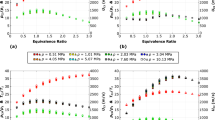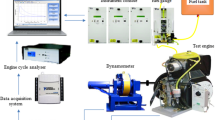Abstract
The influence of variations in engine speed, injection pressure, injection timing, and multiple injection strategies on the combustion and nanoparticle characteristics of a small Direct injection (DI) diesel engine was experimentally investigated. To measure the size distribution and number concentration of particle emissions, a rotating disk thermo-diluter (dilution system), a Condensation particle counter (CPC), and a Scanning mobility particle sizer (SMPS) were used. The injection pressure was changed from 60 MPa to 120 MPa, at an engine speed of 1200 rpm. Injection timing was varied from Before top dead center (BTDC) 40˚ to Top dead center (TDC). To investigate the effect of multiple-injection strategies, the injection strategies consisted of two pulse signals with different dwell time. The experimental results show that the peak combustion pressure and Rate of heat release (ROHR) profile are increased and ignition delay is shortened with the increase of injection pressure from 60 MPa to 120 MPa. The concentration of soot emission for 120 MPa is lower than that of 60 MPa at advanced injection timing from TDC up to BTDC 25°. As the injection timing advances to over BTDC 30°, soot emissions rapidly increase and the high injection pressure case (120 MPa) creates more emissions than the 60 MPa case. The overall trends of total particle number are relatively increased with high injection pressure for single injection conditions. In the advanced injection timings of over BTDC 30°, the trend of total particle number is high for all injection pressures. For multiple injections, the peak combustion pressures and ROHR of multiple-injection strategies are slightly lower compared with those of single-combustion results. Comparing the multiple injection strategies, soot emission is reduced with the retard of second injection timing (-30°+5°). The overall trends of particle size and total number for the 7 mg+3 mg case revealed the lowest level compared with other cases, which is 50% lower than that for the 5 mg+5 mg case. When compared with single injection results, the total particle number and Dp of multiple injection cases were eventually lower.
Similar content being viewed by others
References
S. Choi, W. Park, S. Lee, K. Min and H. Choi, Methods for incylinder EGR stratification and its effects on combustion and emission characteristics in a diesel engine, Energy, 36 (12) (2011) 6948–6959.
I. S. Jo, M. C. Chung, S. M. Kim, G. S. Sung and J. W. Lee, Experimental investigation and hydraulic simulation of dynamic effects on diesel injection characteristics in indirect acting piezo-driven injector with bypass-circuit system, International J. of Automotive Technology, 16 (2) (2015) 173–182.
X. Wang, Z. Huang, W. Zhang, O. A. Kuti and K. Nishida, Effects of ultrahigh injection pressure and microhole nozzle on flame structure and soot formation of impinging diesel spray, Applied Energy, 88 (5) (2011) 1620–1628.
B. Yin, J. Wang, K. Yang and H. Jia, Optimization of EGR and split injection strategy for light vehicle diesel low temperature combustion, International J. of Automotive Technology, 15 (7) (2014) 1043–1051.
M. Ishida, S. Yamamoto, H. Ueki and D. Sakaguchi, Remarkable improvement of NOx-PM trade-off in a diesel engine by means of bioethanol and EGR, Energy, 35 (12) (2010) 4572–4581.
S. J. Harris and M. M. M. Aricq, Signature size distributions for diesel and gasoline engine exhaust particulate matter, J. of Aerosol Science, 32 (2001) 749–764.
G. Oberdorster, Toxicology of ultrafine particles: in vivo studies, Philosophical Transactions of the Royal Society A, 358 (1775) (2000) 2719–2740.
S. H. Lee, J. H. Kwak, S. Y. Lee and J. H. Lee, On-road chasing and laboratory measurement of exhaust particle emissions of diesel vehicles equipped with after-treatment technologies (DPF, Urea-SCR), International J. of Automotive Technology, 16 (4) (2015) 551–559.
H. Kim and J. Lee, Quantitative analysis of vehicle particle emission by using calibrated CPC system, JMST, 25 (11) (2011) 2959–2967.
S. Yoon, D. C. Quiros, H. A. Dwyer, J. F. Collins, M. Burnitzki, D. Chernich and J. D. Herner, Characteristics of particle number and mass emissions during heavy-duty diesel truck parked active DPF regeneration in an ambient air dilution tunnel, Atmospheric Environment, 122 (2015) 58–64.
D. Kittelson, Engines and nanoparticles: a review, J. of Aerosol Science, 29 (1998) 575–588.
J. Pagán, Study of particle size distributions emitted by a diesel engine, SAE Technical Paper (1999) SAE 1999-01-1141.
C. P. Wong, T. L. Chan and C. W. Leung, Characterisation of diesel exhaust particle number and size distributions using mini-dilution and ejector-diluter measurement technique, Atmospheric Environment, 37 (2003) 4435–4446.
J. M. Desantes, V. Bermudez, J. M. Garcia and E. Fuentes, Effects of current engine strategies on the exhaust aerosol particle size distribution from a heavy-duty diesel engine, Aerosol Science, 36 (2005) 1251–1276.
J. B. Heywood, Internal combustion engine fundamentals, NewYork: McGraw-Hill (1988).
L. M. Pickett and D. L. Siebers, Soot in diesel fuel jets: Effects of ambient temperature, ambient density, and injection pressure, Combustion and Flame, 138 (2004) 114–135.
R. M. Montajir, T. Jusaka, Y. Bamba and M. Adachi, A new conception for real-time measurement of particulate matter (Soot and SOF), SAE Technical Paper (2005) SAE 2005-01-3605.
K. Sato, O. Shinozaki, T. Seto, C. Kim, K. Okuyama, S. Kwon and K. W. Lee, The origins of nanoparticle modes in the number distribution of diesel particulate matter, SAE Technical Paper (2002) SAE 2002-01-1008.
P. Tan, D. Lou and Z. Hu, Nucleation mode particle emissions from a diesel engine with biodiesel and petroleum diesel fuels, SAE Technical Paper (2010) SAE 2010-01-0787.
J. Benajes, R. Novella, S. Arthozoul and C. Kolodziej, Particle size distribution measurements from early to late injection timing low temperature combustion in a heavy duty diesel engine, SAE Technical Paper (2010) SAE 2010-01-1121.
M. Y. Kim, S. H. Yoon and C. S. Lee, Impact of split injection strategy on the exhaust emissions and soot particulates from a compression ignition engine fueled with neat biodiesel, Energy & Fuels, 22 (2) (2008) 1260–1265.
C. Park, S. Kook and C. Bae, Effects of multiple injections in a HSDI diesel engine equipped with common-rail injection system, SAE Technical Paper (2004) SAE 2004-01-0127.
F. Mallamo, M. Badami and F. Millo, Analysis of multiple injection strategies for the reduction of emissions, noise and BSFC of a DI CR small displacement non-road diesel engine, SAE Technical Paper (2002) SAE 2002-01-2672.
Author information
Authors and Affiliations
Corresponding author
Additional information
Recommended by Associate Editor Jeong Park
Seung Hyun Yoon is an Assistant Professor of the Department of Automotive Engineering, Yeungnam University College, Daegu, South Korea. He received the B.Sc., M.Sc. and Ph.D. degrees in Mechanical Engineering from Hanyang University. His research interests include alternative fueled vehicle using bioethanol, biodiesel, and dimethyl ether (DME).
Su Han Park is an Assistant Professor of the School of Mechanical Engineering, Chonnam National University, Gwangju, South Korea. He received the B.Sc., M.Sc. and Ph.D. degrees in Mechanical Engineering from Hanyang University. He has much interests in the fuel injection/spray/atomization characteristics and advanced combustion technologies (LTC, HCCI, RCCI etc.) for the development of Clean Engine System.
Rights and permissions
About this article
Cite this article
Yoon, S.H., Park, S.H. Experimental investigation on the influence of engine operating conditions on combustion and nanoparticle emission characteristics of a small DI diesel engine. J Mech Sci Technol 30, 2839–2848 (2016). https://doi.org/10.1007/s12206-016-0543-5
Received:
Revised:
Accepted:
Published:
Issue Date:
DOI: https://doi.org/10.1007/s12206-016-0543-5




